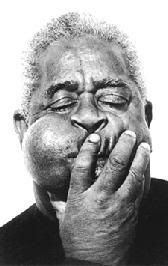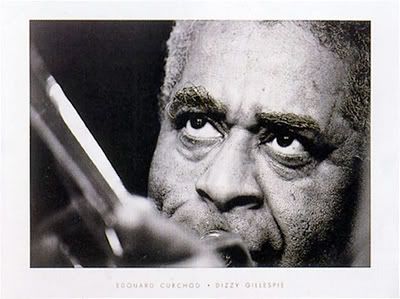So what to my great delight shows up in BIG image form when I open the lovely My Left Wing blog today?
The best picture of Dizzy Gillespie ever taken, that’s what.
Here’s a smaller version.

And here is another one of my favorites.

Do y’all have any idea of how heavy ol’ Diz really was?
Betcha you don’t.
Read on for more, from a lifelong student of his life AND his music.
Why am I a jazz musician?
Because my mother brought home a record from the cutout bin in a white suburban supermarket one day when I had the flu or something. To cheer me up. It had the picture of a trombone on the cover (They didn’t put pictures of black people on record covers in the late ’50s. Bet on it. Talk about segregation!!!) and I was playing trombone in my junior high school band. Of course, there were no trombones on the record, but the ripoff motherfuckers who ran the music business mostly couldn’t tell a trombone from a hole in the wall at the time (It’s no different now…) and it was only a buncha Negro junkies playing some kind of Chinese sounding shit anyway, so why bother. Right?
The record?
Bird, Diz, Charles Mingus, Bud Powell and Max Roach in concert at Massey Hall, Toronto, circa 1953. Real music does not GET any deeper.
My life changed forever that day.
Bet on THAT, too.
Read on.
As Diz woulda said about ALLA this shit…
“Oop bop shebam, kluglemop!!!”
Sheerly a genius, John Birks Gillespie may have been the heaviest of them ALL.
Heavier than Bird, and that’s SAYIN’ something.
How?
Because he survived.
How did he survive?
Why?
Because he had a heart as big as the universe, and a head to match.
And because his response to all negativity was laughter.
Well…also an occasional knife to the ass. (He cut Cab Calloway while Cab was in full flight after unjustly accusing Diz of throwing spitballs during one of Cab’s rehearsals. Of course, Diz had STARTED the spitball thing in the band, but that day? Nope. It wasn’t him. There was a certain line level sort of reality and gravitas to being a black jazz musician in those days. ANY kinda being black. I mean…Diz didn’t kill him. He just kinda…made his point, so to speak.)
Not only did he play the trumpet faster, higher, and with more rhythmic, harmonic and melodic complexity than any human being who has so far lived, he wrote pieces that are still too difficult harmonically for all but the greatest players, pieces that sound simple!!! (The bridge to “Manteca”, all of “Con Alma”. Believe it.) His harmonic wisdom was simply astounding. Practical harmonic wisdom, as in “How can I do this and still play with soul?”
He was the first of his jazz-playing generation to involve himself in the music of the OTHER dark meat…he called it Afro-Cuban Jazz, and that’s close enough for me. He invented it. Him and and a bunch of Cubans and Nuyoricans who came towards jazz from the other side, people like Chano Pozo, Mario Bauza and Bobby Rodriguez. Never heard of ’em? No surprise. This is REAL American Culture 101, not the tripe you are sold through the edumacational system and the media.
He became a Baha’i in his 50s and was all of his life a DEEPLY spiritual man. His OWN damned way. (“Baha’i??? Whazzat!!!???” Oh, you never heard about them, either? You could look it up. They stand to establishment Islam kinda the same way that Quakers stand to Christianity. YOU know…all the good stuff without the swords and cannons?)
I play in a NY big band that is led by his long-time pianist Mike Longo…another heavy, one of the few that really understand where Diz was coming from on all levels…and the band plays music that is heavily influenced by Diz’s work once a month at the Baha’i Center in NY. A great band playing superb music. The band has been rehearsing, performing and recording…on a shoestring, mostly (A broken shoestring, more often than not.)…for over 10 years in NY. On its good days, it plays on as high a level as jazz is played anywhere in the world today.
MAYBE 100 people show up on those once a month Baha’i Center Tuesday nights. Which is fortunate, because I think the whole auditorium would only seat about 150. That’s out of 8 million + New Yorkers. The power of the media to cloud the minds of Americans is one of the few things on earth more astounding than was Diz’s talent. Serious American jazz players who play in serious large art ensembles have a running joke that goes something like this when they see only a few people in the audience. “Whew!!! Thank God we outnumber ’em!!!”
Yup.
Well, Dizzy Gillespie “outnumbered” all of us, all by himself.
Curious about Diz?
Go listen.
It’s all available right from your damned computer. You don’t even have to go outside anymore.
“Yawn…I wonder what Fifty Cent is up to these days…”
Suit yo’selves, oh sleeping ones…
The music is so strong that it lives without you.
WIDE awake and still growing.
Bet on it.
Later…
AG
P.S. Curious about the cultural cross currents that could produce a Dizzy Gillespie? From a sleepy South Carolina town to a jazz icon in about 30 years? Here is one of this Irishman’s favorite reference works. (ALL of Cassidy’s stuff. Google it. Amazing. REAL American history.)
The Bunkum of Bunkum (for Dizzy Gillespie) by Daniel Cassidy.
An excerpt:
Ironically the old congressman from Buncombe County may have been speaking Gaelic buanchumadh (pron. buan’cumah, a long made-up story) after all. North Carolina had an historic Scots-Gaelic and Irish-speaking population up until the beginning of the 20th century. The jazz musician Dizzy Gillespie’s family were African-American Gaelic speakers from North Carolina and Alabama. So Buncombe County may have been the origin of bunkum as buanchumadh, (pron. buan-cumah, “a shaggy dog tale”) after all.
“Under an enormous image of (Dizzy) Gillespie beamed on to a wall at Sprague (Hall), Yale music professor Willie Ruff salutes his old friend and explains to the audience how this musical journey began. “Dizzy used to tell me tales of how the blacks near his home in Alabama and in the Carolinas had once spoken exclusively in Scots Gaelic. He spoke of his love for Scotland…..” (The Scotsman newspaper, Sept. 25, 2005. http://living.scotsm…
African-American Scots-Gaelic and Irish speakers were not limited to the American South. The Irish and Gaelic languages are hidden strands of both African- and Irish- American Vernacular. Ya’ tuig (pron. dig, understand, comprehend)? Tuig é nó ná, (pron. dig ay no naa, understand it or not), according to both enumerations of the 1870 U.S. Federal census, 12% of the African-American community in New York City was Irish-African-American.
Hmmmmm…
Put THAT in your cultural pipe and smoke it.
Diz did.
As well as many other substances, of course.
Dig it
Ya’ tuig?
AG



Ya’ tuig???
AG
Let’s eat more meat.